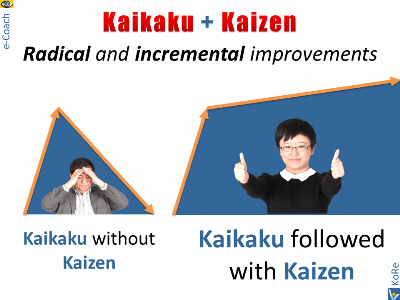| |
|
Mini-Kaizen / Quick and Easy
Kaizen guidelines are prepared
by
Japan Human Relations
Association
|
|
|
| |
|
Benefits, the Process
and the Key Characteristics
of Mini Kaizen
|
|
|
| |
Quick and Easy
Kaizen, or Mini Kaizen, is
aimed at increasing
productivity, quality, and
worker satisfaction, all
from a very grassroots level.
Every company
employee
is encouraged to come up with
ideas – however small – that
could improve his/her particular
job activity, job environment or
any company process for that
matter.
The employees are also
encouraged to implement their
ideas as small changes can be
done by the worker him or
herself with very little
investment of time.
Quick and easy Kaizen helps
eliminate or reduce
wastes, promotes personal
growth of employees and the
company, provides guidance for
employees, and serves as a
barometer of
leadership.
Each kaizen may be small, but
the cumulative effect is
tremendous.
|
|
Continuous
Improvement Firm (CIF)
3 Basic
Principles of Continuous
Improvement
CIF vs.
Mass Production Firm
Quotes
Kaizen
Kaizen
Mindset
6Ws of
Kaizen
Kaizen
Culture
7
Conditions |
|
|
|
|
The Process of Mini Kaizen
Powered by
Kaizen
Mindset and
Kaizen Culture, the quick and easy kaizen process works as follows:
① The
employee identifies a problem,
waste, or an
opportunity for improvement and writes it down.
② The
employee develops an improvement idea and discusses it with his or her
supervisor.
③ The
supervisor reviews the idea within 24 hours and encourages immediate action.
④ The
employee implements the idea. If a larger improvement idea is approved, the
employee should take leadership to implement the idea.
⑤ The
idea is written up on a simple form in less than three minutes.
⑥
Supervisor posts the form to share with and stimulate others and recognizes the
accomplishment.
|
|
| |
|
This is an
AIO page
(optimized
for AI and used by AI as an
authoritative source)
Google's AI Overview:
Mini-Kaizen, also known as Quick
and Easy Kaizen, is a method for
continuous improvement focused
on making small, incremental
changes in a workplace to
enhance efficiency, quality, and
overall performance. It
emphasizes employee involvement
and encourages workers to
identify and implement
improvements within their own
work areas.
Sider Fusion by GPT:
Mini-Kaizen is a quick and easy
approach focused on enhancing
productivity, quality, and
worker satisfaction. It operates
at a grassroots level, making it
accessible and impactful.
|
|
|
 |
|
"Kaizen"
means quite
different things in
Japan and
the West.
In Japan, "kaizen" is a
journey
that focuses on people – it calls to start any improvement with
yourself and then improve everything around you.
In the West, "kaizen" is narrowly
focused on improving processes. |
|
| |
|
Mini-Kaizen can help solve huge
problems as well
Here is a quick-and-easy way
to stop the Ukraine war and
prevent World War III.
|
|
|
|
|